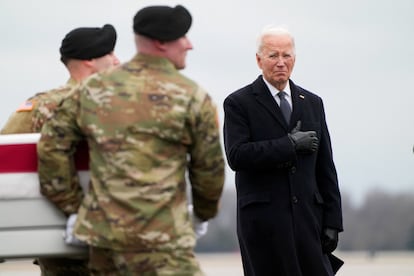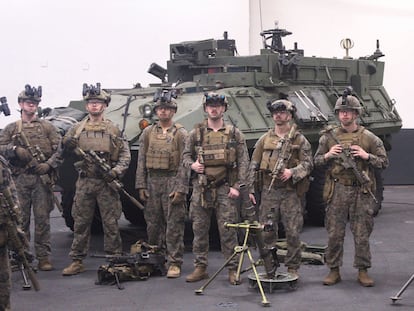Fear of escalation moderates US retaliation against pro-Iran militias in Syria and Iraq
Russia’s deputy representative to the United Nations, Dmitry Polyansky, called for an urgent meeting of the UN Security Council following the attacks

Retaliation was not only expected. It was announced by U.S. President Joe Biden, who stated last Tuesday that he had already decided how Washington would react to the drone attack against a U.S. base in Jordan two days earlier, in which three military personnel were killed. However, its materialization on Friday, with strikes against more than 85 targets linked to Iranian-backed militias in Iraq and Syria, has raised concerns about a possible escalation in the Middle East. Friday’s strikes killed 23 people guarding the facilities in Syria, according to the Syrian Observatory for Human Rights, and 16 in Iraq, including civilians near the targeted sites, the government in Baghdad said. On Saturday, further strikes by the U.S. and U.K. air forces targeted 36 sites operated by the Houthi rebels in Yemen, including weapons dumps and missile systems. Russia’s deputy representative to the United Nations, Dmitry Polyansky, called for an urgent meeting of the UN Security Council following the attacks on Iraq and Syria.
As was also to be expected, the countries targeted, and Iran, have criticized the retaliation. Iraqi Prime Minister Mohammed Shia’ Al Sudani — who has been combining conciliatory statements toward Washington with calls for the anti-ISIS coalition forces it leads to leave the country — said the strikes have placed the security of Iraq and the wider region “on the brink of the abyss.” The Syrian government, supported by Russia and Iran in its 13-year civil war, called the United States “the main source of global instability,” while Tehran spoke of Washington’s “strategic error.” “Such attacks increasingly involve the U.S. government in the region and overshadow the crimes of the Zionist regime in Gaza,” Ministry of Foreign Affairs spokesperson Nasser Kanaani was reported as saying.
The head of European diplomacy, Josep Borrell, has warned that the Middle East is “a cauldron that could explode” and has asked all actors in the region to avoid an escalation. Washington has been targeting Houthi militias, which are also backed by Iran, mainly around the strategic Red Sea port of Al Hodeida, since January 12 in an attempt to destroy their ability to strike international shipping heading toward the Suez Canal with missiles and drones.
Despite the warning signs, the manner of the U.S. retaliation, at least in this first phase, does not seem to be designed to risk expanding the conflict. Washington — which in 2020 killed General Qassem Soleimani, commander of the elite Revolutionary Guard Al Quds force, in a drone strike in Baghdad in response to several deadly attacks against U.S troops in Iraq — could have opted for the selective assassination of a militia leader or for targeting Tehran more directly.
The targets instead were limited to “command and control operations centers, intelligence centers, rockets, missiles, unmanned aerial vehicle storage, and logistics and munition supply chain facilities,” according to the U.S. Central Command. “The United States does not seek conflict in the Middle East or anywhere else in the world. But let all those who might seek to do us harm know this: If you harm an American, we will respond,” Biden said on February 2.
According to analysts and experts, the attacks were prudent and limited in their objectives in order not to further stoke tension in the region. CNN analyst Nick Paton Walsh defines the initial strikes as a “comparatively limited” response to the deaths of the three military personnel, the worst loss of U.S. lives in the region in almost three years. The Biden administration, the expert explained, “faced a near-impossible task: Hit hard enough to show you mean it, but also ensure your opponent can absorb the blow without lashing out in return.”
Added to this is the speed with which Iran disassociated itself from the attack on the base in Jordan, which left Washington in a delicate position: interpreting it as a mere ploy to throw the stone and hide the hand would have meant raising the tension several notches. Additionally, there is the assumption that the announcement by the group that claimed responsibility, Kata’ib Hezbollah, that it was suspending all its operations against U.S. troops would not have materialized without pressure from Tehran, which is similarly eager to avoid an open conflict.
A difficult balance
Preventing further attacks on its forces deployed in the region, without provoking an escalation, has been the mantra of the few public reactions to the U.S. strikes. Defense Secretary Lloyd Austin corroborated that the operation was only the opening salvo in an offensive whose scope and timetable is being kept secret. The strikes are only “the beginning of our response,” Austin said, echoing Biden’s statement that “it will continue at times and places of our choosing.”
The barrage of attacks lasted just 30 minutes, National Security Council spokesman John Kirby said Friday. “This was designed around the weather, when we had our best opportunity as it related to the weather […] good weather presented itself today. And as a result, this took place,” added Lt. Gen. Douglas Sims, director of the Joint Chiefs of Staff. Washington is analyzing satellite images to assess the extent of the damage, i.e. the number of casualties among pro-Iranian fighters, but the White House believes it was successful, Kirby said. The spokesman also stated that the authorities in Baghdad were warned of the strikes in advance — something they deny — and that there has been no contact with Iran since the drone attack carried out by Kata’ib Hezbollah, which forms part of the Islamic Resistance in Iraq, a generic name that groups together different armed factions supported by Tehran.
The attack against the U.S. Tower 22 base in Jordan, in which at least 25 soldiers were also wounded, was not unusual (hundreds have been recorded in recent years, particularly since the beginning of the war in Gaza), but it was the only one that managed to penetrate air defenses. The drone was mistaken by U.S. troops for one of its own that was due to return to base, according to U.S. commanders.
Since October 7, when the Hamas attacks in Israel triggered the Gaza war and other skirmishes in the region, from Lebanon to Yemen, Syria and Iraq, U.S. forces deployed in the Middle East have been targeted by over 160 attacks by militias linked to Iran, according to the Pentagon’s count.
Sign up for our weekly newsletter to get more English-language news coverage from EL PAÍS USA Edition
Tu suscripción se está usando en otro dispositivo
¿Quieres añadir otro usuario a tu suscripción?
Si continúas leyendo en este dispositivo, no se podrá leer en el otro.
FlechaTu suscripción se está usando en otro dispositivo y solo puedes acceder a EL PAÍS desde un dispositivo a la vez.
Si quieres compartir tu cuenta, cambia tu suscripción a la modalidad Premium, así podrás añadir otro usuario. Cada uno accederá con su propia cuenta de email, lo que os permitirá personalizar vuestra experiencia en EL PAÍS.
¿Tienes una suscripción de empresa? Accede aquí para contratar más cuentas.
En el caso de no saber quién está usando tu cuenta, te recomendamos cambiar tu contraseña aquí.
Si decides continuar compartiendo tu cuenta, este mensaje se mostrará en tu dispositivo y en el de la otra persona que está usando tu cuenta de forma indefinida, afectando a tu experiencia de lectura. Puedes consultar aquí los términos y condiciones de la suscripción digital.
More information
Archived In
Últimas noticias
Welcome to the post-religion era: The idea of Christianity as the absolute truth has become obsolete
‘I thought you would like it’: The risky sexual practice popularized by TV shows and TikTok
The digitalization of tourism: ‘They promise experiences and gave us the worst possible one’
Mexican peso defies uncertainty with forecasts of a new period of stability in 2026
Most viewed
- Sinaloa Cartel war is taking its toll on Los Chapitos
- Oona Chaplin: ‘I told James Cameron that I was living in a treehouse and starting a permaculture project with a friend’
- Reinhard Genzel, Nobel laureate in physics: ‘One-minute videos will never give you the truth’
- Why the price of coffee has skyrocketed: from Brazilian plantations to specialty coffee houses
- Silver prices are going crazy: This is what’s fueling the rally










































